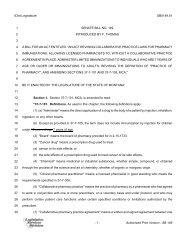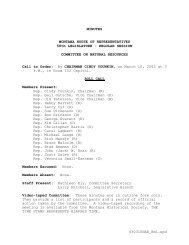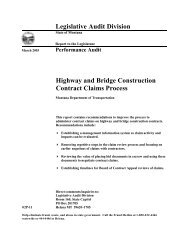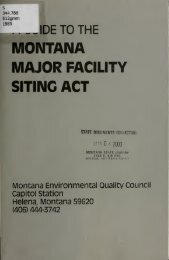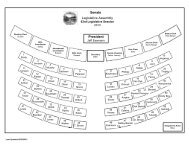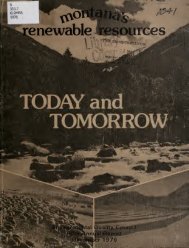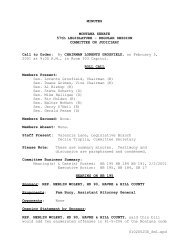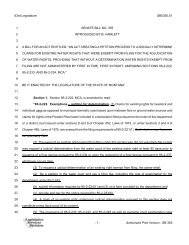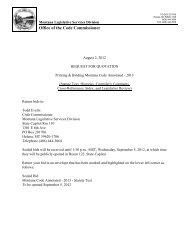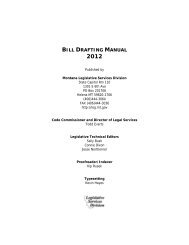Public Comment. Volume III - Montana Legislature
Public Comment. Volume III - Montana Legislature
Public Comment. Volume III - Montana Legislature
Create successful ePaper yourself
Turn your PDF publications into a flip-book with our unique Google optimized e-Paper software.
DRAFT, 4/ 9/ 8 5 23<br />
ces . These permits are required wherever -construction<br />
activities may cross .any stream -bed. or. bank - (ephemeral.<br />
or perennial). As a result, each crossing of a stream<br />
bed, dry or not, requires such a permit.<br />
In addition to these very detailed permit processes, a<br />
number Of other safeguards can be built into the final design of<br />
the rail line. Some of these include:<br />
(1) A ll culverts and other drainage structures installed at<br />
ephemeral and perennial stream crossings will be,<br />
designed to pass the projected 100-year flood.<br />
(2) Where possible, the proposed route is designed to avoid<br />
the flood plain. Where the railroad grade does infringe<br />
upon the flood plain, drainage structures should<br />
be installed to assure that the grade does not restrict<br />
or re-route the 100-year flood.<br />
(3) To prevent unnecessary degradation of water quality due<br />
to erosion, revegetation efforts 2hould begin as soon<br />
as possible after construction is complete in a given<br />
area, (See revegetation section, 10.3.)<br />
(4) Spills of fuel or other toxic or hazardous substances<br />
which may affect water quality should ;be addressed in<br />
the manner described in the section on safety,<br />
(5) Construction of all stream crossings, including bridges<br />
and culverts and such activities as require stream bank<br />
encroachments (rip-rap, for example), 8hould be timed<br />
to occur during' 'periods of low or no flow in the<br />
streams affected, The vast majority of stream beds<br />
traversed by the railroad are dry most of the year, so<br />
such scheduling should not be difficult .<br />
It also should be noted that a study has been conducted to<br />
determine the extent to which the Tongue River Railroad would<br />
constrict the flood waters from a disaster such as a breach of<br />
the Tongue River Dam. The study shows that the railroad grade .<br />
would, to some extent, alter the inundation pattern, but would<br />
not appreciably affect the disaster plans as discussed in the<br />
Tongue River Dam Emergency Warning and Evacuation Plan, published<br />
by the <strong>Montana</strong> Department of Natural Resources and Conservation,<br />
-206- <strong>Volume</strong> Ill: <strong>Public</strong>' <strong>Comment</strong>



